Share this link via
Or copy link
One of the best Japanese Kanji dictionary.
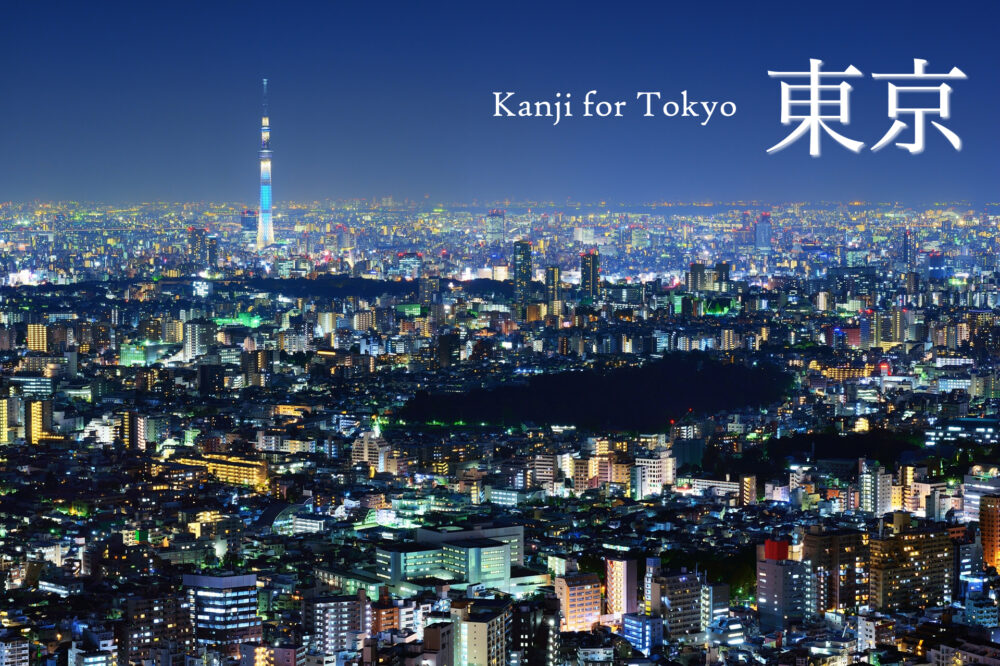
Kanji for Tokyo is 「東京」. Tokyo, pronounced Tōkyō in Japanese, is the capital of Japan.
Contents
However, its history as the official capital is shorter than you might think.
It was in 1868, the year of 明治維新(Meiji Ishin, the Meiji restoration)  , that the capital moved from Kyoto to Tokyo as the Emperor moved its residence. Before that, Tokyo was called「江戸」(Edo)
, that the capital moved from Kyoto to Tokyo as the Emperor moved its residence. Before that, Tokyo was called「江戸」(Edo)  . Since 徳川家康(Tokugawa Ieyasu)
. Since 徳川家康(Tokugawa Ieyasu)  has started the 江戸幕府*(Edo Bakufu, Edo Shogunate)
has started the 江戸幕府*(Edo Bakufu, Edo Shogunate)  ’s rule in Edo in 1603, Edo was the center of Japanese politics and economy.
’s rule in Edo in 1603, Edo was the center of Japanese politics and economy.
However, the capital of Japan was still Kyoto because the Emperor stayed there until 1868. The 徳川 family had the authority to rule Japan only because the Emperor had given them the position as 征夷大将軍(Seiitaishōgun)  , the top of a Shogunate.
, the top of a Shogunate.
*「幕府」(Bakufu), or Shogunate in English, is the noun for the military governments that ruled Japan from 1192 to 1868.
「東」 means “east” and 「京」means “capital.” Therefore, the name 「東京」has the meaning of “the eastern capital,” since Tokyo is located east of Kyoto.
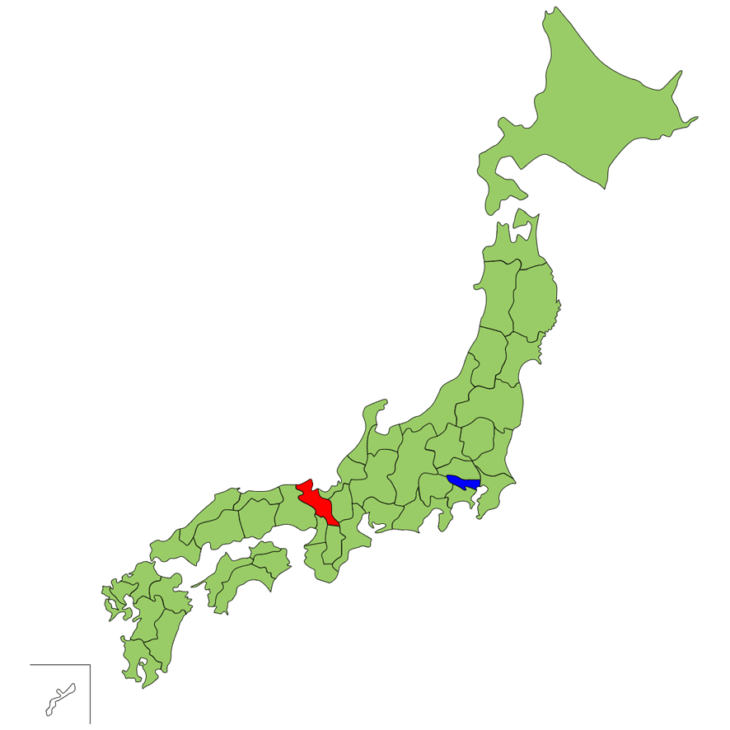
Tokyo colored in blue and Kyoto colored in Red
Nowadays, Tokyo is the name of a prefecture. The prefecture is called 「東京都」(Tōkyō-to)  . Only Tokyo uses「都」(to) for the English word “prefecture.” Other prefectures are called 県(ken), 府(fu), or 道(dō). In English, 東京都 is called the “Tokyo Metropolis” or “Tokyo Metropolitan area”; however, it is the same as a prefecture as an administrative district.
. Only Tokyo uses「都」(to) for the English word “prefecture.” Other prefectures are called 県(ken), 府(fu), or 道(dō). In English, 東京都 is called the “Tokyo Metropolis” or “Tokyo Metropolitan area”; however, it is the same as a prefecture as an administrative district.
There used to be a city called 東京市(Tokyo city), but now the area is called 23区(Nijūsan-ku) since 1943 when 東京都 was made by integrating 東京府 and 東京市 that existed from 1868. 区(ku) means “ward.”
If you are interested in writing big numbers in Kanji, please see our article below for further information:
How to write numbers in Japanese – Vertical writing and horizontal writing
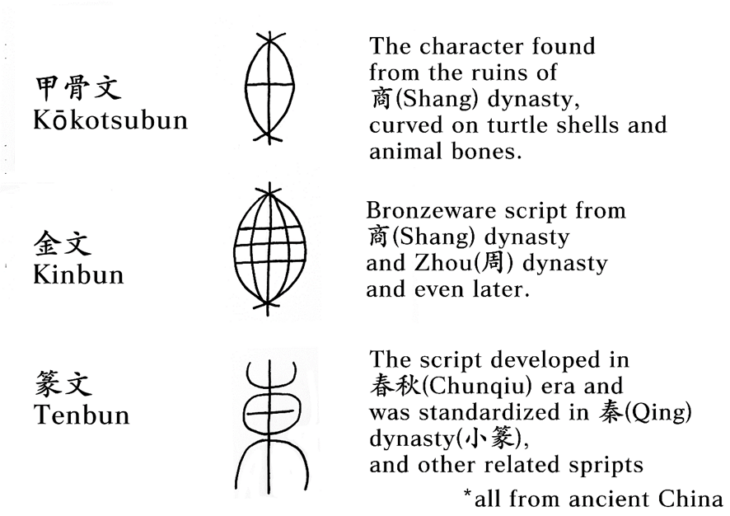
東(east) is a pictogram of tying up both ends of a bag. From the image of moving a heavy bag, it refers to the direction where the sun rises. Another thesis says that 東 is a logogram that shows the direction where the sun rises because the sun(日) is written inside the tree(木).
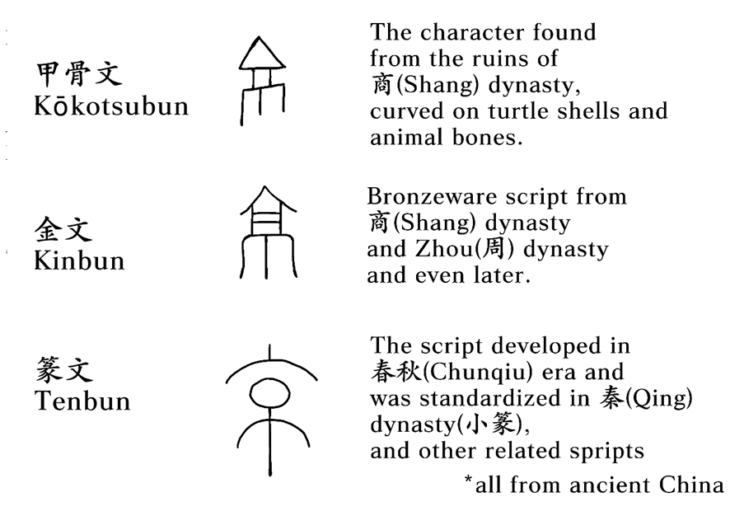
京 is a pictogram of a house built on a high hill. It means “high hill,” “capital,” or “big.” The other Kanji characters that have 京 as a block to show the sound, for example, 景(kei), share the meaning of “a big, high hill.”
*景 is used in Kanji compounds like風景(fūkei meaning “scenery”) or 景色(keshiki meaning “view”).
The Kanji characters for Kyoto is 「京都」, and both 京 and 都 means “capital.”
Nowadays, when you say just「京」(Kyō) in one character, it means Kyoto, and when you say「都」(To), it means Tokyo. However, the verb 「上京する」(jōkyōsuru) means “to go to Tokyo.”
「上」means “up.” The word comes from the custom that the nearer you get to the capital or a prosperous place, it is considered that you are moving upwards, and the further you get, you are moving downwards(「下」meaning “down”).
This way of thinking appears when describing the transportation, for example,「上りの電車」(Nobori no densha, inbound train) and 「下りの電車」(Kudari no densha, outbound train). 「電車」(densha) is a Kanji compound of 電(electricity) and 車(car), meaning “train.”
 : east
: east : west
: west : south
: south : north
: northAll together, they are called 「東西南北」(tōzainanboku)  .
.
There are other places named by combining “the direction” and “京” besides Tokyo.
For example, 北京 (pronounced “Pekin” in Japanese) means Beijing and 南京 (Nankin) means Nanjing in China. They are written in the same ways in Chinese too. It is irregular to read 北 as “pe” and 京 as “kin” in Japanese, and it is read so only when speaking about the name of the two cities, or the nouns with their names like 北京ダック(Pekin dakku, meaning Peking Duck).
There are many places called 西京 or 西ノ京 as their official name or alias. The most famous place with the name 西京 in Japan is the 西京区(Nishikyō-ku) in Kyoto City.
If you would like to know how to describe the directions between 東西南北, please read the article below.
東京駅(Tōkyō eki)  : Tokyo Station
: Tokyo Station
「駅」(eki) means “station.” Tokyo Station is the terminal station of many It is famous for its beautiful, photogenic retro building surrounded by skyscrapers.
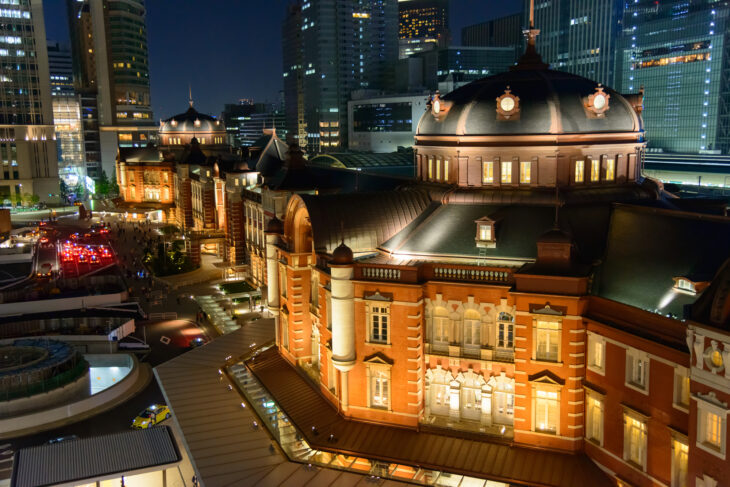
Go to the 丸の内(Marunouchi) side to take the photo of the retro view, not the 八重洲(Yaesu) side. Seen from the 八重洲 side, the station has a totally different face as a modern building.
東京都庁(Tōkyō Tochō)  : Tokyo Metropolitan Government Office, or the Tokyo Metropolitan Government Building
: Tokyo Metropolitan Government Office, or the Tokyo Metropolitan Government Building
The office is near 新宿(Shinjuku), one of Tokyo’s most bustling places. The building is extremely high, and what is amazing is that you can go up to the observatory for free. If you want to see Tokyo’s nightscape from other famous spots such as Tokyo Tower, Tokyo Skytree, or Roppongi Hills Mori Tower, you have to pay a certain amount of money to go up.
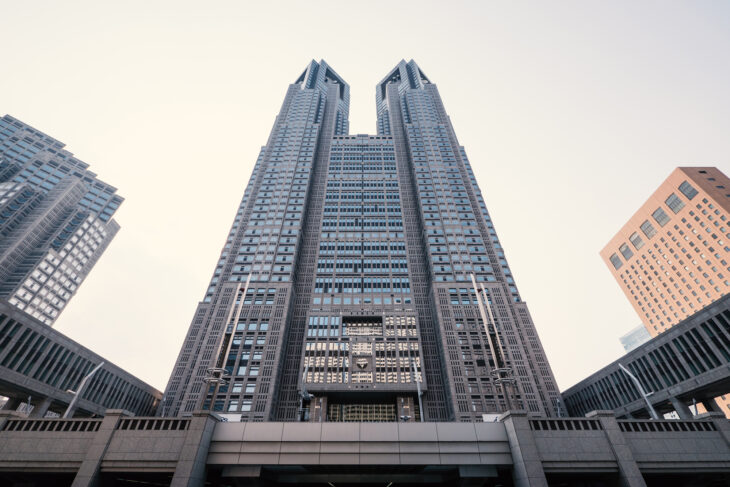
東京ディズニーランド(Tōkyō Dizunī Rando)  and 東京ディズニーシー(Tōkyō Dizunī Shī)
and 東京ディズニーシー(Tōkyō Dizunī Shī)  : Tokyo Disney Land and Tokyo Disney Sea
: Tokyo Disney Land and Tokyo Disney Sea
These are two famous amusement parks of Disney located in Urayasu City, Chiba prefecture. Chiba prefecture is in the east of Tokyo, so their names with “Tokyo” may sound funny. They are well known as “a country of dream and magic.”
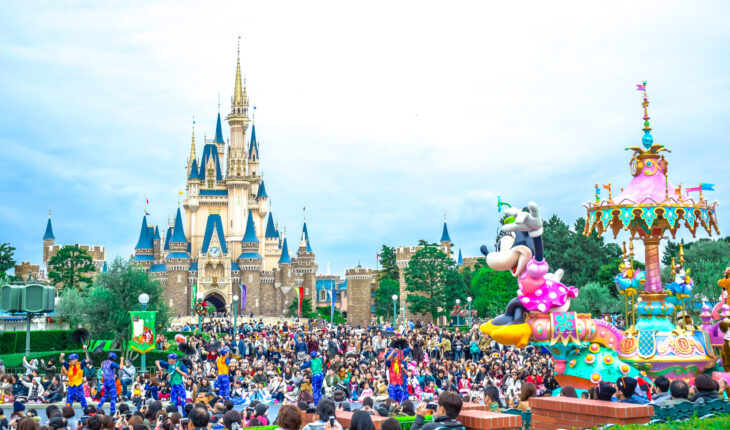
Disney’s Magic Happens Parade at front of Cinderella Castle, the landmark of Tokyo Disneyland
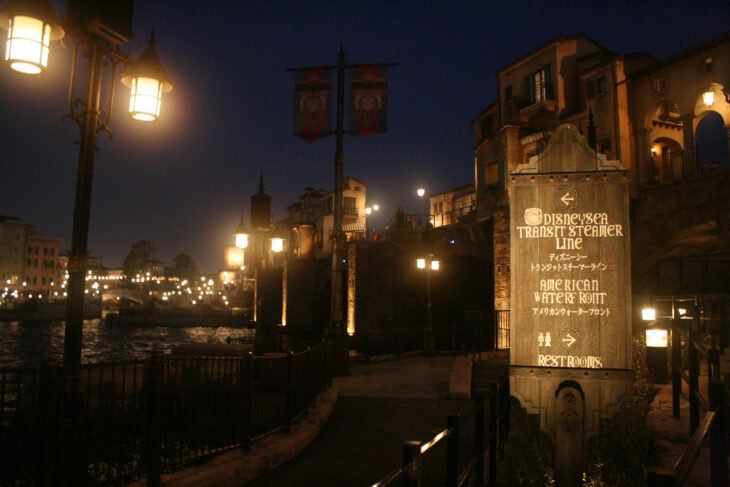
The nightscape of Tokyo Disney Sea
東京メトロ(Tōkyō Metoro) 
Its English name is “Tokyo Metro.” It is a company that runs nine out of thirteen subway lines in Tokyo.
The other four are run by the Tokyo Metropolitan Bureau of Transportation, a part of the Tokyo Metropolitan Government. The four are called 「都営地下鉄」(Toē chikatetsu).「営」means “to run,” and 「地下鉄」means “subway.” 「地下鉄」is a Kanji compound made of 地(the ground), 下(down), and 鉄(basically means metal, but in this context it stands for 鉄道[tetsudō], meaning “railroad”).
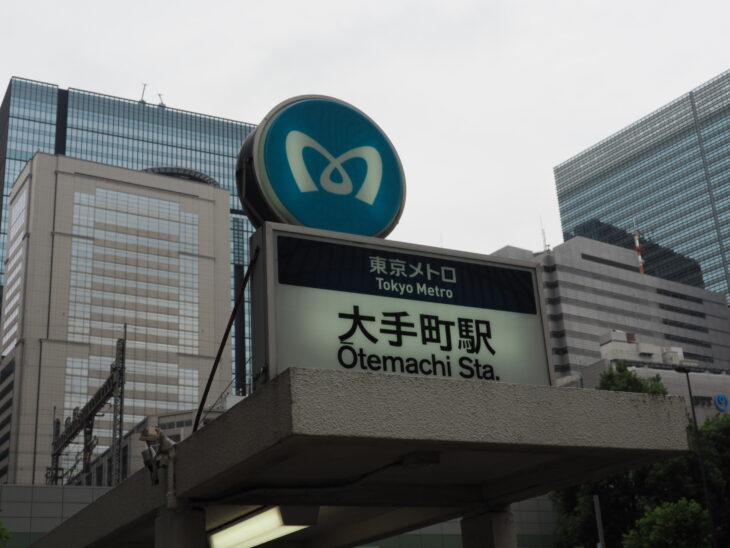
Search for this “M” logo to find the exit of the station of Tokyo Metro
Here is the map of the subway in Tokyo. Can you imagine how complicated -or crazy, in other words – it is?
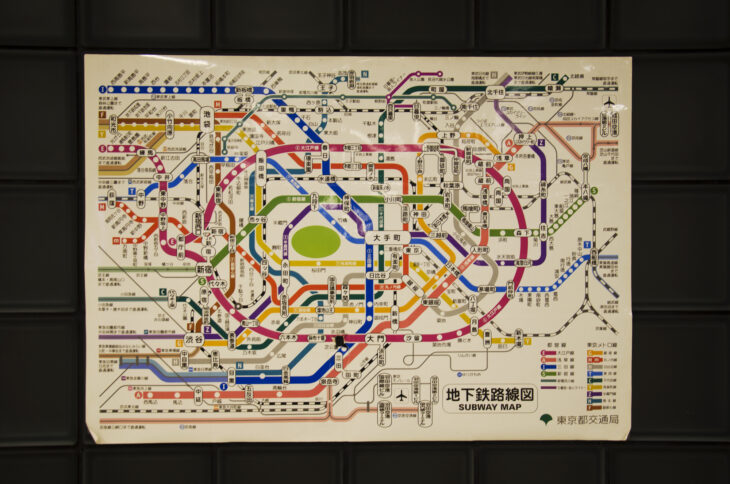
Information route map pole of subway and railway of Tokyo metro
Plus, when you travel to Tokyo, you have to use various lines of trains running on the ground. Maybe it seems too complicated, but don’t worry, just use the Google Map to find out where to change trains.
東京証券取引所、東証(Tōkyō Shōken Torihikijo  , or Tōshō
, or Tōshō  for short): Tokyo Stock Exchange
for short): Tokyo Stock Exchange
「証券」 means “securities” and 「取引」 means “dealing” or “trading.” 「所」is the character for “place.”
東証株価指数(Tōshō kabuka shisū)  or TOPIX for short, means “Tokyo stock price index.”
or TOPIX for short, means “Tokyo stock price index.”
東京裁判(Tōkyō Saiban)  : The Tokyo Trial
: The Tokyo Trial
東京裁判 is another name of 極東国際軍事裁判(Kyokutō Kokusai Gunji Saiban) or The International Military Tribunal for the Far East (IMTFE) in English. It is a military trial in 1946 to try the leaders of Japan as war criminals of World War II. 「裁判」 means “trial” or “court.”
東京電力、東電(Tōkyō Denryoku  , or Tōden
, or Tōden  for short): Tokyo Electric Power Company Holdings, Incorporated, or TEPCO in short
for short): Tokyo Electric Power Company Holdings, Incorporated, or TEPCO in short
TEPCO is the company holdings that supply electricity not only to Tokyo but also to Gunma, Tochigi, Ibaraki, Saitama, Chiba, Kanagawa, Yamanashi, and Shizuoka prefecture. It is known for having nuclear powerplants only outside where they supply their electricity. The Fukushima Daiichi Nuclear Power Station, where the nuclear disaster occurred due to the earthquake in 2011, belongs to TEPCO.
東京大学、東大(Tōkyō Daigaku  , or Tōdai
, or Tōdai  in short): The University of Tokyo, or UTokyo for short
in short): The University of Tokyo, or UTokyo for short
UTokyo is the top university in Japan and is said to be the hardest one to pass the entrance examination.
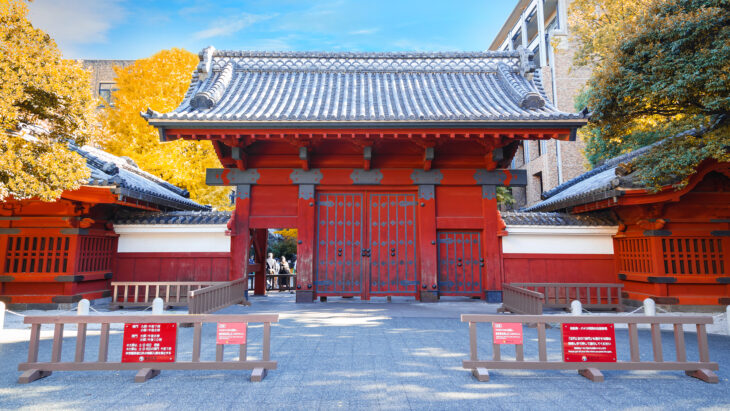
赤門(Akamon, literally “the red gate”) of the 本郷(Hongō Campus) is the symbol of UTokyo
However, The Times Higher Education World University Rankings 2021 ranked UTokyo in 36th place. Kyoto University, the another top university of Japan in Kyoto, is in the 54th. Some people deplore that they are ranked lower than other Asian universities such as Tsinghua University (20th) and Peking University (23rd) in China and the National University of Singapore(25th place). If you look at the precise data of the ranking, you will notice that the weak points of UTokyo are citations and international outlook. In other words, UTokyo’s theses are not cited so much by other researchers, and it has fewer international students, teachers, and international joint research projects than other universities in the world.
The Times Higher Education World University Rankings 2021(Official Site)
I cannot say whether this ranking is appropriate or not. Theses need to be written in English in order to be cited by foreign researchers. English-speaking countries’ universities clearly have an advantage in terms of language. Besides, this ranking seems to be more focused on the science field than Social Sciences and Humanities.
However, it is widely said that Japan’s research environment is terrible, and unfortunately, it’s getting worse. The Japanese government is using less and less money for national universities. Researchers say that it is getting more difficult to get the government’s budget year by year. Also, it is not easy for those who completed their Ph.D. to get a stable job as a researcher. Some Japanese Novel Prize winners say that they had to go outside to the US to thoroughly pursue their work. What’s worse, the Japanese government asked the national universities to abolish the faculties of Social Sciences and Humanities and shift their focus on other fields in 2015.
Making a better research environment is a controversial issue in Japan, especially discussed when the Novel Prize winners of the year are announced.
On April 1st, 2020, Tokyo’s population was more than13 million, and that was more than 10% of Japan’s total population, which was 125 million on the same day. The population density is extremely high. Furthermore, many people commute to work or go to school in Tokyo from the neighboring prefectures such as Chiba, Kanagawa, and Saitama. The area that includes Tokyo and these prefectures is called 「首都圏」(Shutoken), which is called “the Tokyo Metropolitan area” in English. 「首都」(shuto) means “capital,” and 「圏」(ken) means “area.” The commuting trains are unbelievably crowded and are called 「満員電車(Man’in densha)」, meaning “jam-packed trains.” At many stations, there is even staff for pushing people into the doors of the train.
Actually, Tokyo is a city of “aliens.” Since there are many universities and jobs in Tokyo, people gather from all over Japan. There is a word 「江戸っ子」(Edokko)  , literally meaning “a person of Edo,” but you need to live in Tokyo for three generations to call yourself that way.
, literally meaning “a person of Edo,” but you need to live in Tokyo for three generations to call yourself that way.
That is precisely the reason why Tokyo has been sung in so many songs.
According to this article, there are 841 songs that include “Tokyo” in their titles or lyrics.
The artists sometimes sing the hanker for living in the city by the people in the countryside, or the feelings of young people moving to Tokyo to make their dreams come true. Some sing the joy of living in the city, and others sing the people’s feelings missing their hometown from Tokyo. When you listen to Japanese music and hear the word “Tokyo” in the lyrics, please think about what kind of feelings the artist wanted to express.
Here are some videos of the songs with “Tokyo” in their lyrics. One is a famous tune in the 90s, and another is the latest hit song in 2020.
東京は夜の七時(Tōkyō wa yoru no shichiji) by PIZZICATO FIVE
This song was a great hit in the 90s. It embodied the sophisticated life in Tokyo. The remix was used in the closing ceremony of the Rio Paralympics in 2016 to show that the next Paralympics will be held in Tokyo.
春を告げる (Haru o tsugeru) by yama
This song went viral through the Internet in 2020.
It starts with the words「深夜東京の六畳半」(Shinya Tōkyō no rokujōhan)  , meaning “a room of 6.5 jō in Tokyo at midnight.” 畳(jō) is a unit to count a room’s size, especially a Tatami room. 1畳 is about 1.82 square meters. Therefore, 6畳半(半 means “half”) is approximately 10.94 square meters. Many people live alone in an apartment with just one room of 6畳, a tiny bath, toilet, and a small kitchen in Tokyo. Therefore, this 六畳半 has some kind of reality, a person living in a smaller house than the other regions because of Tokyo’s high rent.
, meaning “a room of 6.5 jō in Tokyo at midnight.” 畳(jō) is a unit to count a room’s size, especially a Tatami room. 1畳 is about 1.82 square meters. Therefore, 6畳半(半 means “half”) is approximately 10.94 square meters. Many people live alone in an apartment with just one room of 6畳, a tiny bath, toilet, and a small kitchen in Tokyo. Therefore, this 六畳半 has some kind of reality, a person living in a smaller house than the other regions because of Tokyo’s high rent.
The title means “Telling that the spring has come.” People will associate this title with the hopeful atmosphere of the season changing from winter to spring, and the beginning of a new chapter in life. Schools and the financial year in companies start in April in Japan; therefore, spring is the season to start a new lifestyle.
However, this song is about the last day of the world. There is no portrayal of that kind of atmosphere. The title is intentionally used to emphasize the gloomy feeling and the sense of emptiness in the lyrics ironically, reflecting the mood of the year 2020.
What is Onyomi?
Onyomi, also known as the "Sino-Japanese reading," is one of the two main reading systems for kanji characters in Japanese. It refers to the reading of a kanji character that is derived from the original Chinese pronunciation.
What is Kunyomi?
Kunyomi, also known as the "native Japanese reading," is one of the two main reading systems for kanji characters in Japanese. It refers to the reading of a kanji character that is based on the native Japanese pronunciation. Kunyomi readings are often used when a kanji character stands alone or is followed by hiragana, as in verbs and adjectives. Mastering both kunyomi and onyomi is crucial for understanding and using kanji effectively in the Japanese language.
What is Radical?
A radical, also known as "bushu" in Japanese, is a fundamental component of kanji characters. Radicals are the building blocks of kanji and are used to categorize and organize them in dictionaries. There are 214 traditional radicals, each with its own meaning, which often provides a clue to the meaning of the kanji character it forms.
What is strokes?
Stroke count, or "kakusuu" in Japanese, refers to the number of individual brushstrokes required to write a kanji character. Each kanji has a specific stroke order and stroke count, which are essential for writing the character correctly and legibly. Understanding and following the correct stroke order not only ensures proper balance and aesthetics but also makes writing more efficient and fluid.